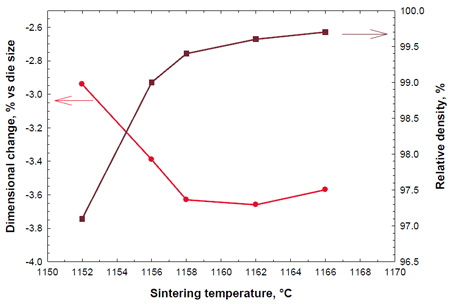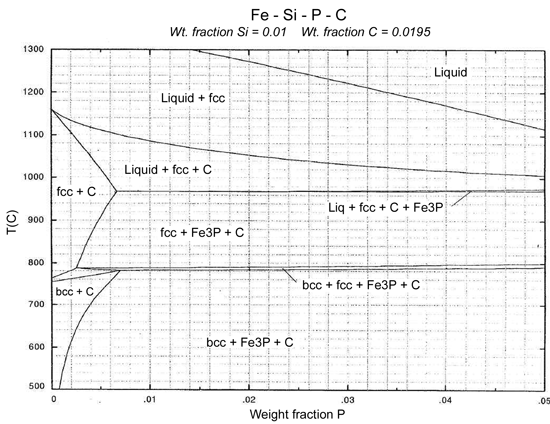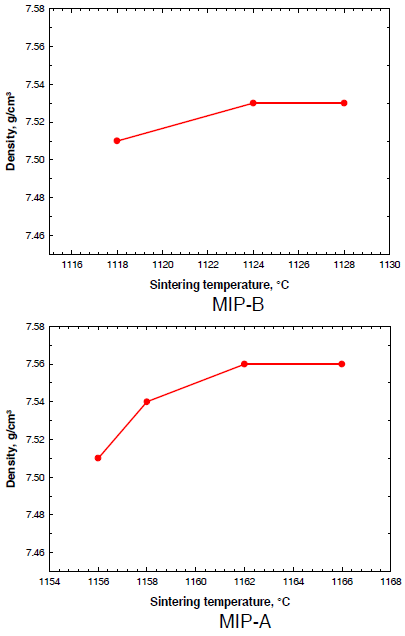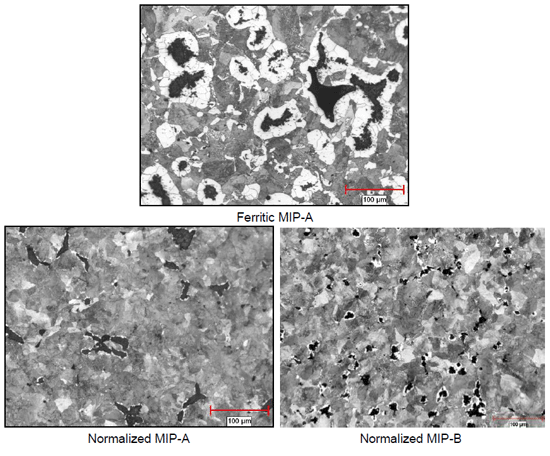PM2012 World Congress: Malleable Iron Powders – Route to High Performance PM parts
In cast iron metallurgy, a white cast iron is subjected to a malleabilisation heat treatment after casting to convert the original cementite phases into graphite nodules.
In the PM approach revealed, the graphite is precipitated within and around the surfaces of the raw material powder particles during the annealing heat treatment stage of the powder production process. Also, a powder composition is selected, which is capable of creating close to full density on sintering at conventional ferrous PM sintering temperatures, through supersolidus liquid phase sintering (SLPS).
Development of a New Malleable Iron Powder Grade
In the first generation development of this concept, discussed in a paper by F Chagnon and C Coscia, the powder composition selected to achieve these objectives was Fe-2%C-1%Si, with the precise compositional details and physical properties being given in Table 1.
The compressibility of this powder was fairly modest (Fig. 1) and the samples used in this test programme were compacted at 650 MPa to achieve a green density around 6.6 g/cm3.
However, by appropriate control over the sintering cycle, it was found that sintered densities of 7.54 to 7.56 g/cm3 (i.e. 99% of full density or higher) could be attained within a sintering temperature window of 1158 to 1166°C. The influence of sintering temperature on achievable density is shown in Fig. 2 and this figure also shows the high level of linear dimensional change (around 3.7%) generated by the SLPS treatment within the optimum temperature window.
Fig. 3 illustrates the impact of both the green and sintered density on dimensional size change variation and emphasises the need for close control over green density to minimise the variation in the final dimensions of parts made from this powder type. This issue will be returned to later in this report.

Fig. 3 Variation of dimensional change with green and sintered density of specimens pressed with MIP [1]
The evolution of tensile properties with sintering temperature is shown in Fig. 4 and this figure demonstrates that the effects of variations in sintering temperature are quite modest. Within the optimum sintering temperature range, tensile strengths of 776 +/- 11 MPa, yield strengths of 523 +/- 20 MPa and elongations of 2.2 +/- 0.4% can be achieved. These values are comparable to the pearlitic malleable cast iron class 80002 and the ductile iron grade 100-70-03.
Fig. 5 shows that axial fatigue strength is very sensitive to both sintered density level and the number of graphite flakes/mm2 having a dimension greater than 100 µm.
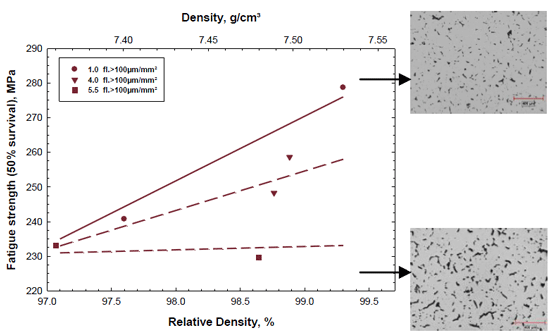
Fig. 5 Effect of density and number of graphite flakes/mm² >100 μm on axial fatigue strength at R = -1 of specimens made with MIP [1]
The issues of the influence of graphite particle shape on fatigue strength and of the control of sintering dimensional change were taken up in the other two papers in this group.
It was recognised that the graphite produced at powder particle surfaces in the initial development was of a flake morphology and that, if graphite morphology could be modified to a nodular form, this could have a positive influence on a range of mechanical and, particularly, fatigue properties.
Effect of Graphite Particle Shape on Static and Dynamic Properties of Malleable Iron Powder Materials
In a second generation development, revealed in a paper by F Chagnon, M Moravej and J Campbell-Tremblay, an addition of 0.2% P in the form of admixed ferrophosphorus was made in order to suppress the SLPS sintering temperature window (see Fig. 6) and retain nodular graphite in the core of the powder particles.
In this study, the composition and physical properties of the base powder (referred to as MIP-A) were as stated in Table 1. As indicated in Table 2, MIP-A also had a 0.5% lubricant addition while MIP-B had additions of both 0.5% lubricant and 0.2% P.
It can be seen from Fig. 7 that, with MIP-A, sintered densities in the range 7.54 to 7.56 g/cm3 can be achieved in the temperature range of 1158 to 1166°C, while, with MIP-B, sintered densities of 7.51 to 7.53 g/cm3 can be achieved at only 1118 to 1124°C. Fig. 8 shows that linear dimensional changes were around -3.9% for MIP-B and -4.1 to -4.2% for MIP-A.
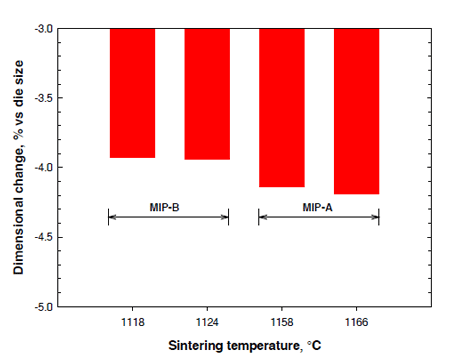
Fig. 8 Dimensional change values measured within the sintering windows of MIP-B and MIP-A materials [2]
This lowering of sintering temperature had the desired influence on graphite morphology and the consequent influence on sintered properties at either end of the optimum temperature window for each of the compositional variants can be seen in Table 3.
The improvement in axial fatigue strength with MIP-B was particularly marked, but there were also useful improvements in tensile strength, yield strength and elongation. The only property that appeared to be inferior with MIP-B was impact energy.
The stated requirement for very precise control over green density levels in order to achieve acceptable control over sintered dimensions after the significant shrinkage occurring during SLPS can lead to the conclusion that the ability to achieve this without post-sintering processing would only be possible within certain product geometry constraints.
Machinability of Malleable Iron Powder Materials vs Ductile Iron and Powder Forged FC-0205 Materials
The final paper in this group, presented by M Moravej, J Campbell-Tremblay and C Labrecque, therefore focussed on the issue of finish machining of the new malleable iron grades.
The machinabilities of the developed malleable iron grades were compared, through face turning tests, with those of a powder forged FC-0205 grade with 0.3% MnS and a ductile cast iron, DI-65-45-12.
The MIP-A grade was assessed in the as-sintered condition, which had a pearlitic matrix with a volume fraction of around 20% ferrite surrounding the graphite particles (this microstructure was termed “ferritic” by the authors). Both MIP-A and MIP-B were also assessed in a normalised condition after sintering and the normalisation treatment had the effect of significantly reducing the volume fraction of ferrite in the microstructure; consequently, this condition was referred to by the authors as “pearlitic”. The microstructures of these various MIP compositions/conditions are shown in Fig. 9.
Two regimes of cutting operation were simulated in the face turning tests: a semi-roughing operation at two different cutting speeds (183 and 274 m/min) and a finishing operation at one cutting speed (137 m/min). In both categories of test, two different lead angles (15 and -5°) were studied.
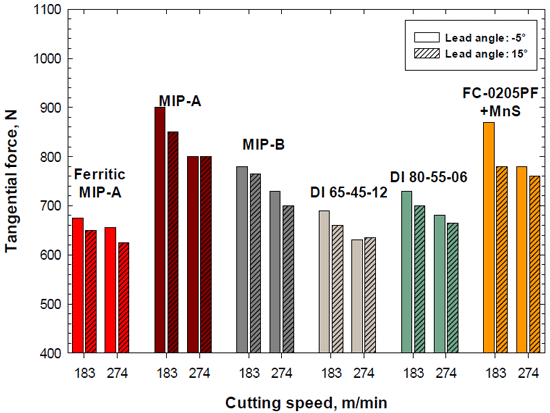
Fig. 10 Tangential force versus cutting speed of MIP materials compared to ductile iron castings and FC-0205 PF+MnS at two different lead angles; semi-roughing operation [3]
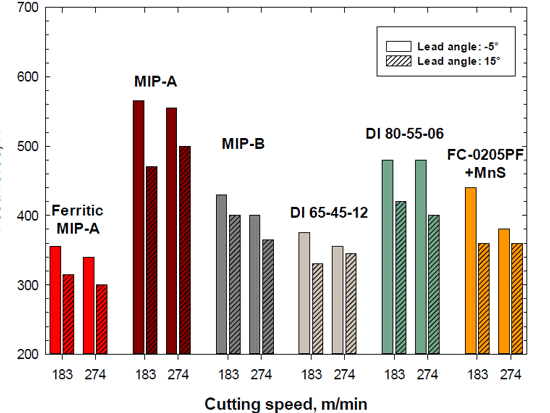
Fig. 11 Feed force versus cutting speed of MIP materials compared to ductile iron castings and FC-0205 PF+MnS at two different lead angles; semi-roughing operation [3]
The results of the semi-roughing tests are shown in Figs. 10 and 11, while those of the finishing tests are shown in Figs. 12 and 13.
Overall, the authors have concluded that the ferritic malleable iron powder parts had similar machinability to the ductile iron DI-65-45-12 and the pearlitic malleable iron parts had similar machinability to DI-65-45-12 and the powder forged FC-0205 grade with 0.3% MnS.
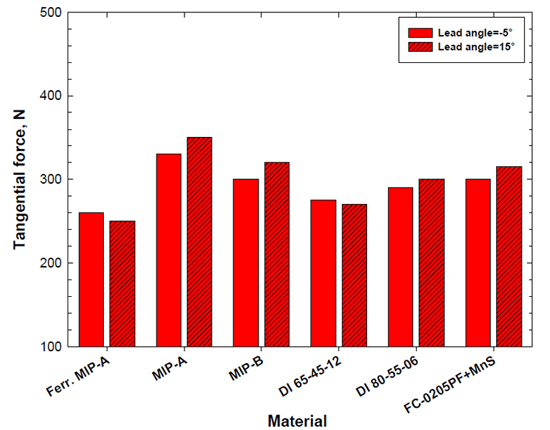
Fig. 12 Tangential force of MIP-A and MIP-B compared to ductile iron castings and FC-0205 PF+MnS at two different lead angles; finishing operation [3]

Fig. 13 Feed force of MIP-A and MIP-B compared to ductile iron castings and FC-0205 PF+MnS at two different lead angles; finishing operation [3]
Figure references
[1] From paper: ‘Development of a New Malleable Iron Powder Grade’ by F. Chagnon, C Coscia, Rio Tinto Metal Powders, Quebec, Canada. Presented at the PM2012 World PM Congress, Yokohama, October 15-18
[2] From paper: ‘Effect of Graphite Particle Shape on Static and Dynamic Properties of Malleable Iron Powder Materials’ by F. Chagnon, M. Moravej, J. Campbell-Tremblay, Rio Tinto Metal Powders, Quebec, Canada. Presented at the PM2012 World PM Congress, Yokohama, October 15-18
[3] From paper: ‘Machinability of Malleable Iron Powder Materials vs Ductile Iron and Powder Forged FC-0205 Materials’ by M. Moravej, J. Campbell-Tremblay, C Labrecque, Rio Tinto Metal Powders, Quebec, Canada. Presented at the PM2012 World PM Congress, Yokohama, October 15-18
PM2012 World Congress Proceedings
Papers presented at the PM2012 World Congress will be published by the JPMA/JSP&PM in the Congress Proceedings, available in early 2013. Further information will be posted on the conference website.
News | Articles | Market reviews | Search directory | Subscribe to e-newsletter




